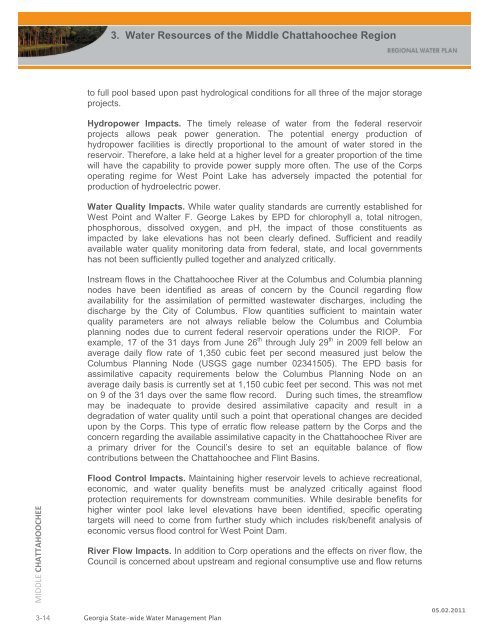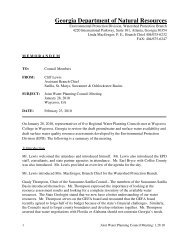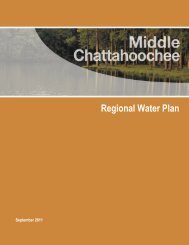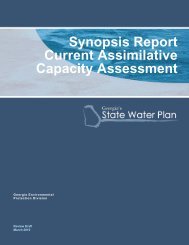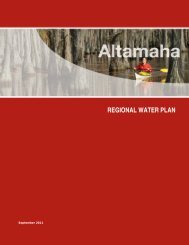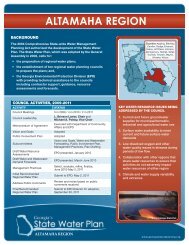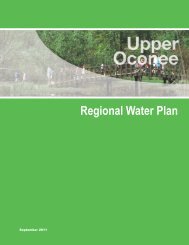Middle Chattahoochee Middle Chattahoochee
Middle Chattahoochee Middle Chattahoochee
Middle Chattahoochee Middle Chattahoochee
- No tags were found...
You also want an ePaper? Increase the reach of your titles
YUMPU automatically turns print PDFs into web optimized ePapers that Google loves.
3. Water Resources of the <strong>Middle</strong> <strong>Chattahoochee</strong> Regionto full pool based upon past hydrological conditions for all three of the major storageprojects.Hydropower Impacts. The timely release of water from the federal reservoirprojects allows peak power generation. The potential energy production ofhydropower facilities is directly proportional to the amount of water stored in thereservoir. Therefore, a lake held at a higher level for a greater proportion of the timewill have the capability to provide power supply more often. The use of the Corpsoperating regime for West Point Lake has adversely impacted the potential forproduction of hydroelectric power.Water Quality Impacts. While water quality standards are currently established forWest Point and Walter F. George Lakes by EPD for chlorophyll a, total nitrogen,phosphorous, dissolved oxygen, and pH, the impact of those constituents asimpacted by lake elevations has not been clearly defined. Sufficient and readilyavailable water quality monitoring data from federal, state, and local governmentshas not been sufficiently pulled together and analyzed critically.Instream flows in the <strong>Chattahoochee</strong> River at the Columbus and Columbia planningnodes have been identified as areas of concern by the Council regarding flowavailability for the assimilation of permitted wastewater discharges, including thedischarge by the City of Columbus. Flow quantities sufficient to maintain waterquality parameters are not always reliable below the Columbus and Columbiaplanning nodes due to current federal reservoir operations under the RIOP. Forexample, 17 of the 31 days from June 26 th through July 29 th in 2009 fell below anaverage daily flow rate of 1,350 cubic feet per second measured just below theColumbus Planning Node (USGS gage number 02341505). The EPD basis forassimilative capacity requirements below the Columbus Planning Node on anaverage daily basis is currently set at 1,150 cubic feet per second. This was not meton 9 of the 31 days over the same flow record. During such times, the streamflowmay be inadequate to provide desired assimilative capacity and result in adegradation of water quality until such a point that operational changes are decidedupon by the Corps. This type of erratic flow release pattern by the Corps and theconcern regarding the available assimilative capacity in the <strong>Chattahoochee</strong> River area primary driver for the Council’s desire to set an equitable balance of flowcontributions between the <strong>Chattahoochee</strong> and Flint Basins.MIDDLE CHATTAHOOCHEEFlood Control Impacts. Maintaining higher reservoir levels to achieve recreational,economic, and water quality benefits must be analyzed critically against floodprotection requirements for downstream communities. While desirable benefits forhigher winter pool lake level elevations have been identified, specific operatingtargets will need to come from further study which includes risk/benefit analysis ofeconomic versus flood control for West Point Dam.River Flow Impacts. In addition to Corp operations and the effects on river flow, theCouncil is concerned about upstream and regional consumptive use and flow returns3-14Georgia State-wide Water Management Plan05.02.2011


